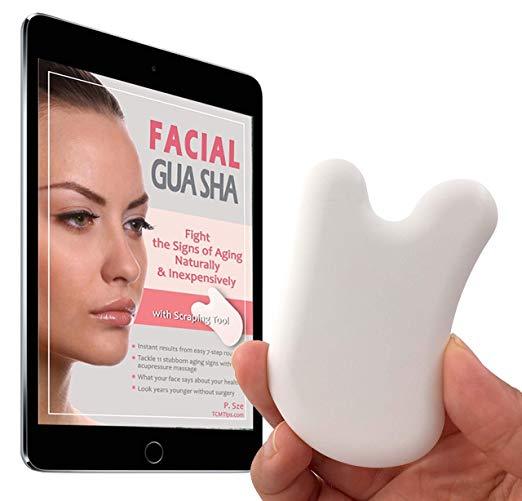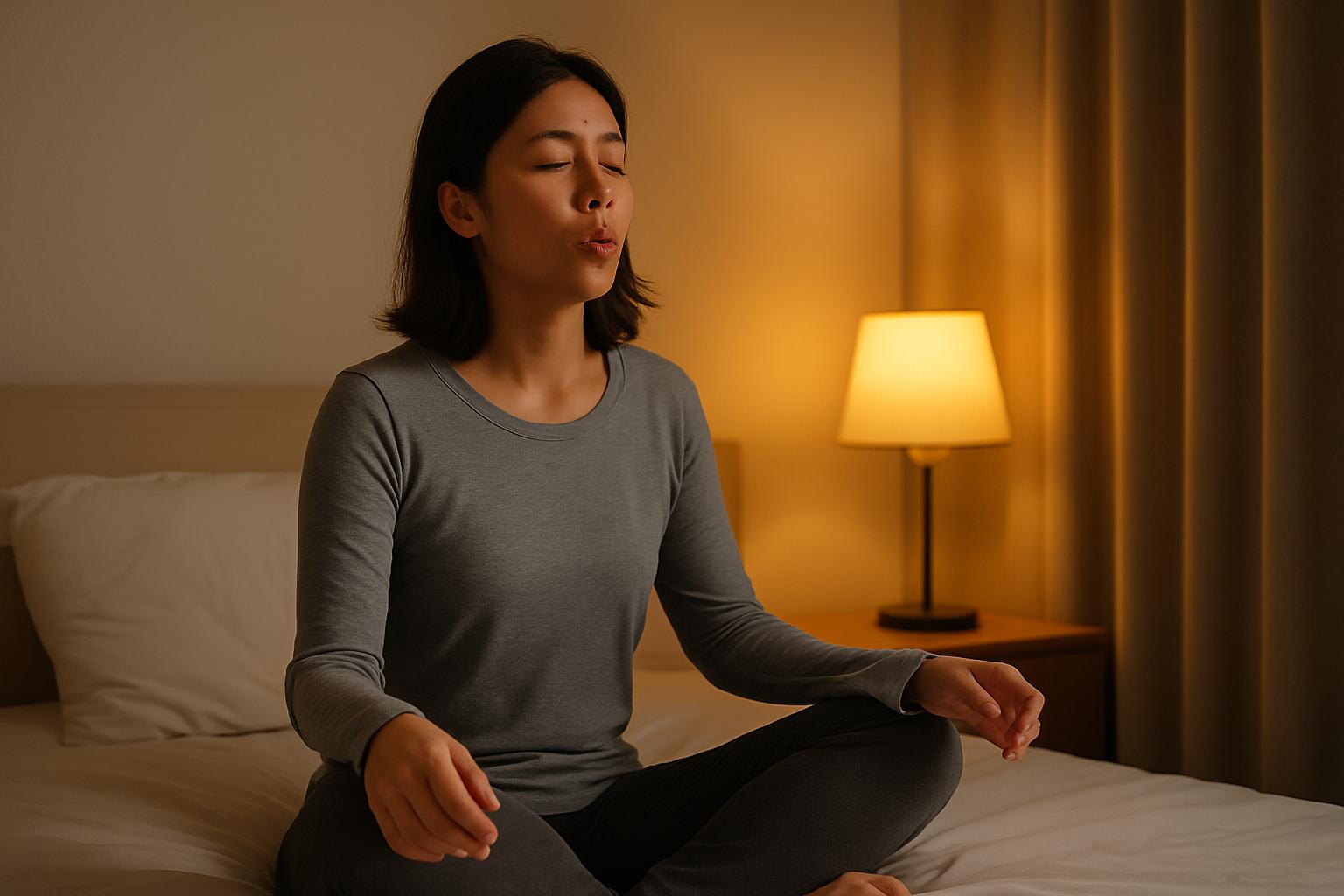Introduction
Gua sha is a massage technique that uses a tool to sweep the body for a therapeutic and relaxing effect. Gua sha tools create petechiae, or sha, which reduces inflammation, circulates stagnated blood, treats pain, tension, stiffness, migraine headaches, and boosts the immune system. Gua sha facials also have anti-aging benefits like skin tightening, wrinkle-reducing, and complexion brightening. After gua sha treatment, you will feel rejuvenated, reenergized, and your skin will look renewed. In order to tap into all these benefits, gua sha treatments require a tool. Follow this buying guide to all the different gua sha tool shapes and their unique abilities and uses.
A gua sha tool is usually made of stone or a durable material like ceramic. They’re flat and can usually fit in the palm of your hand. Gua sha tool shapes are precisely shaped to contour the body and face. Different gua sha shapes use various notches and divots to glide over your body perfectly. The more a gua sha tool retains heat, the better it will glide across the body, improve elasticity, relax tension, and promote healing.
There are many different gua sha tool shapes, and they each have different uses, whether you are using gua sha for the body or the face. Many times the materials the tools are made from are believed to contain energetic or spiritual healing properties.
Gua Sha Tool Shapes
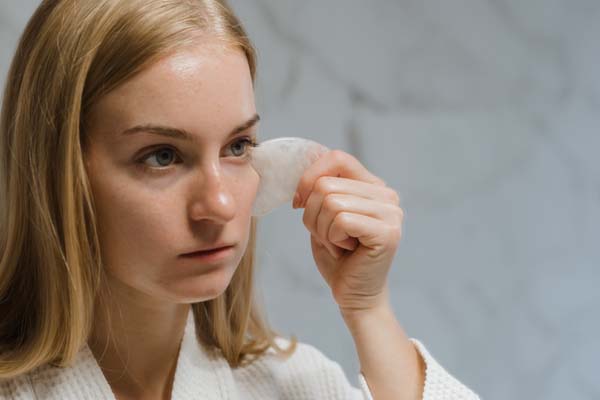
If you’ve just gotten into gua sha and are looking for a proper gua sha tool, it can be overwhelming since the market is so saturated. Gua sha has soared in popularity in recent years because of its proven benefits, so everyone is trying to tap into the market.
However, not all gua sha tools are made equally, nor are they all equally effective. In this guide, you will learn about the different types of gua sha tool shapes, materials, their uses, and their advantages and disadvantages.
These are the five main types of gua sha tool shapes:
1. Wing Shaped Tool
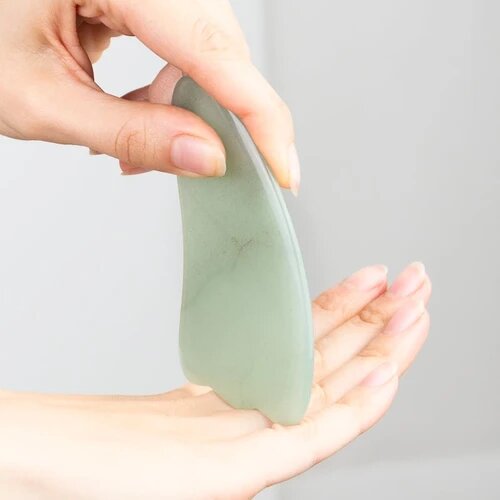
This tool looks like a bird’s wing because of the three small arches on one edge of the tool. This is on the smaller end of gua sha tool shapes and can be held in the palm of your hand. Wing-shaped tools are usually made with stone or semi-precious stones.
A wing-shaped tool can be thought of as a gua sha comb because of the three arches and three sides that can be used for scraping, and it maneuvers over the face with ease. It’s best for the chin, jawline, and forehead and targets smaller facial areas. It’s also great for using on extremities like hands, forearms, and upper arms. If you have a smaller framed body, it can also be used for gua sha on your chest and shoulders.
One limitation of the wing-shaped tool is its size. This tool is best used for gua sha facials since it would be uncomfortable and time consuming to sweep the entire back with such a small tool. Additionally, it is difficult to get a firm grip on the tool because of how small it is.
2. Dolphin Shaped Tool
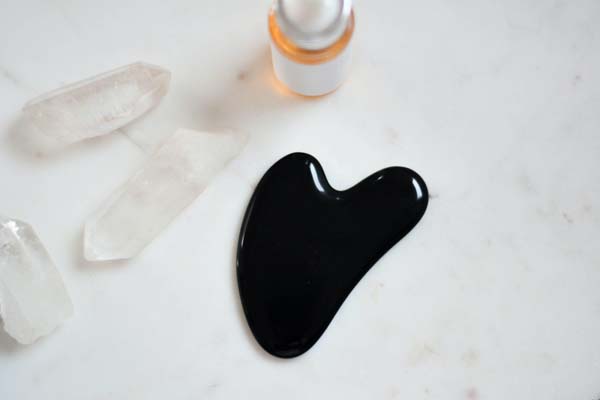
This tool also comes in smaller sizes, which are better suited for the face, neck, and shoulders. The divot on the modified edge reaches underneath the eyes, along the cheekbones, and up the jawline, perfect for gua sha facials. They are usually made from semi-precious stones like jade, amethyst, and rose quartz.
3. S-Shaped Tool
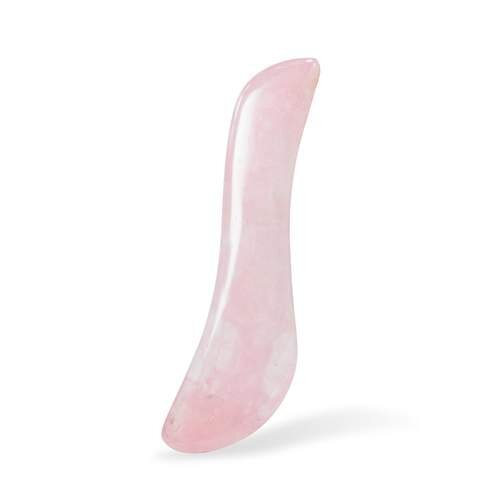
As you might have guessed, this gua sha tool shape resembles an S and is typically a medium-sized tool that can be used for both body and face. The ergonomic design gives you good leverage and allows you to hold one end while applying firm pressure with the other. The thicker side of the S is used to penetrate denser parts of the body like the glutes and thighs, and the thinner side can be used for more sensitive areas like the face and neck.
This shape is extremely versatile and works great on hands, feet, back, neck, and shoulders. Also, because of its unique shape, you can more easily do gua sha on yourself. You’ll find this S-shaped tool made from semi-precious stones like jade, amethyst, and rose quartz, and even sometimes plastic.
4. Square Shaped Tool
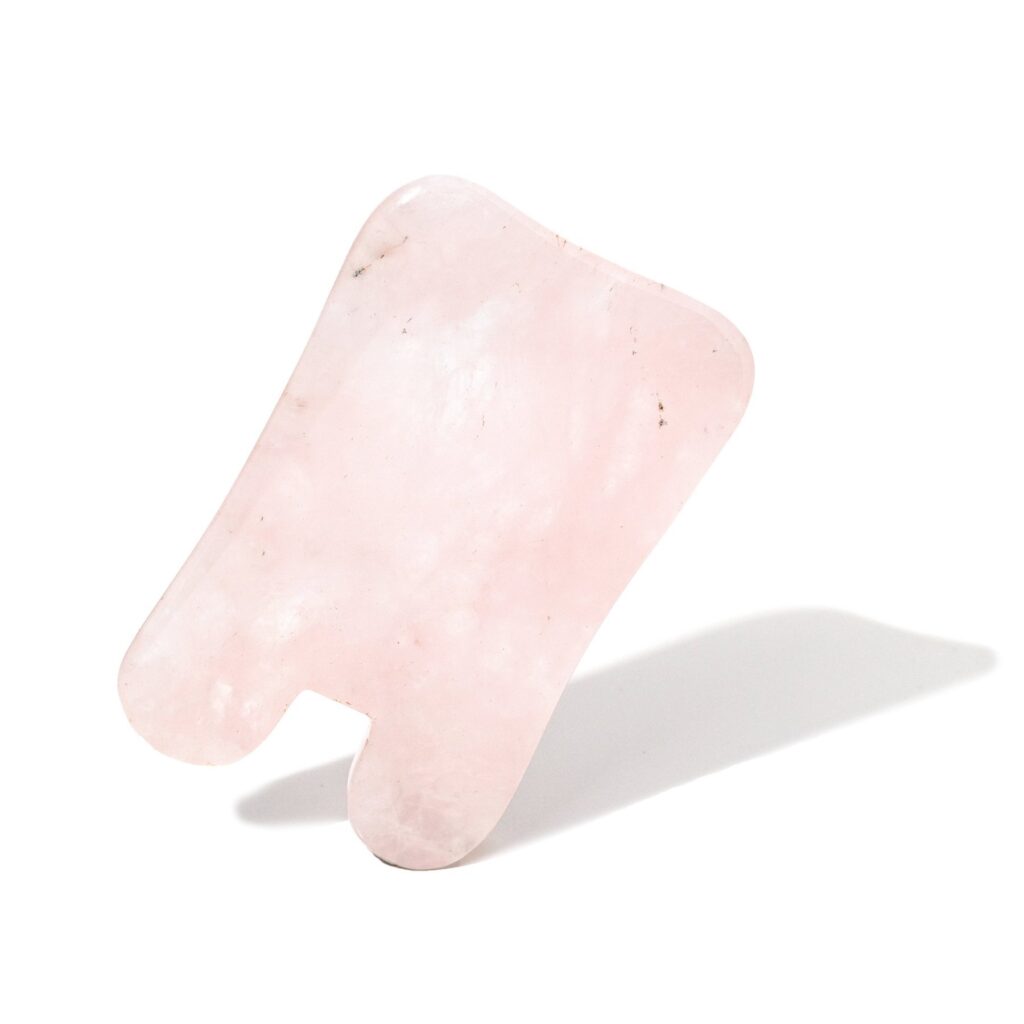
This tool is unlike other gua sha tool shapes because its edges are more linear, and the two notches on one end are very pronounced. This tool shape is best for gua sha facials because of its small size and uniquely shaped notches.
Those notches hug the jawline perfectly to sweep the face. This tool shape is optimized for the brow bone, forehead, cheekbones, and under the eyes. The tips of the notches are for reaching hard-to-get areas on the face. Because of its square shape, you can grip the tool firmly for better control over your sweeps. It works best for stimulating circulation to the face and neck.
5. Heart-Shaped Tool

This heart-shaped tool is so lovely you might not even realize it’s a gua sha tool. A small heart-shaped tool is best used for gua sha facials. It helps lift and sculpt cheekbones, relax forehead and brow bone muscles, refresh undereye bags, and tighten the jawline. The indent of the heart hugs the bones and contours of the face, while the pointed end of the heart serves as a place to grip.
This gua sha tool shape, while cute and sweet, does not have much practical use for people who are serious about gua sha. It’s small and works excellent for sweeps on the face and neck, but its edges are not contoured well for the rest of the body, nor is it practical for firm pressure. It’s typically made from rose quartz because of the pink color.
Other
There are plenty of other gua sha tool shapes on the market, and they all have their advantages and disadvantages. For example, there is a less common gua sha lifting tool that resembles the shape of knuckles to penetrate the body in a natural way. There are also gua sha tools with serrated edges, shaped like an arrowhead, optimized for relieving tension along the back of the neck and the jawline. Another shape is a teardrop tool that is small and straightforward to use because it isn’t contoured. You simply run the rounded end of the tool along your face and smaller parts of the body.
Gua Sha Tool Materials
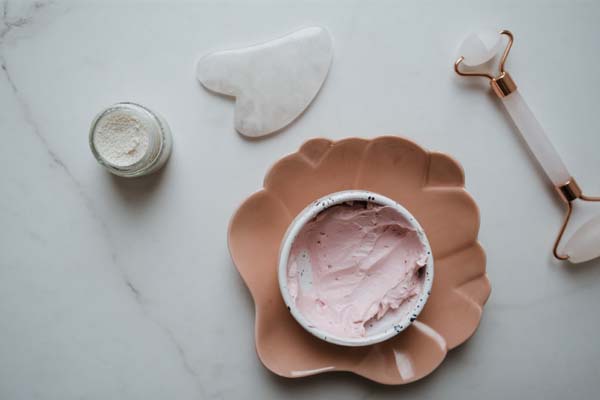
Any product or tool you use on your body, especially your face, should be high-quality, sanitary, and durable. Gua sha skin cleansing is only as good as your gua sha tool and the materials it’s made from. Some stones and semi-precious claim to have healing and balancing properties, while others are dense and useful for deep-tissue gua sha massages.
These are the most commonly used materials for gua sha tools:
Bian Stone
Going back to the roots of gua sha in ancient China, bian stones were commonly used by doctors and spiritual healers. Thirty trace elements are found within bian stones and are beneficial to humans. This incredible stone is not from this earth. It’s rumored that a meteor hit a mountain in ancient China, which resulted in a blast of stones and minerals.
Bian stone healing properties are made possible because of the strong field of energy and negative ions emitted from the stone. When rubbed against the skin, the stone emits ultrasonic impulses that have antioxidant and anti-aging effects. Bian stone improves circulation, purges heat and toxins from the body, and increases oxygen and nutrition supply to the organs and skin. These benefits are in addition to the many benefits of gua sha itself.
Since bian stone is natural and more fragile than other types of stones, avoid cleaning your bian stone gua sha tool with chemicals like detergents and soaps. This is how to clean bian stone: wash with pure, room-temperature water, and leave in the sun for a few hours to activate the stone. Heat is the primary activator of bian stone’s healing effects.
Bian stone is more rough and abrasive than other stones, so that it might leave you with a gua sha rash. Bian stone should be used after you are experienced with gua sha, and with plenty of lubrication.
Jade
Jade and nephrite gua sha tools are the most commonly used materials. Jade is used for many things in Chinese medicine because of its Qi energy balancing properties. It’s said to soothe the mind, release negative thoughts and irritability, and calm the nervous system. Additionally, it’s believed that jade helps strengthen the body’s filtration system (kidneys, gallbladder, and liver), boost the immune system, and relieve pain.
You may have noticed jade rollers became a fad in skincare recently. This is thanks to the benefits of jade, not necessarily the roller itself. While it has benefits for complexion and toning, gua sha works more effectively than just rolling. Jade is a cool stone, which helps disperse heat in the face and body. It’s a smooth stone and glides smoothly over the skin, even more so with proper lubrication.
To clean a jade gua sha tool, wash with warm water and dish soap. Let it dry, then spray with isopropyl alcohol to kill off bacteria, and store in a clean, dry place until the next use. Here is a more detailed guide on how to clean your gua sha tool.
Rose Quartz
Gua Sha for acne? Rose quartz gua sha tools are ideal for sensitive skin, such as people who suffer from acne or rosacea. On a spiritual level, rose quartz is known as the stone of love. It opens the heart and promotes inner healing and a feeling of peace, calms and reassures, and encourages self-love and self-acceptance. On a healing level, rose quartz strengthens and balances the circulatory system, purges impurities from the body through the kidneys, promotes recovery, and restores energy.
Rose quartz tools aren’t just pretty and pink; they are versatile and durable. They are best used for facial gua sha since they do not agitate sensitive skin. It can improve skin elasticity, reduce puffiness and wrinkle lines, ease tension, and help your skin absorb products.
Wash a rose quartz gua sha tool in the same manner as a jade tool. You might be wondering, what’s the difference between jade vs. rose quartz gua sha? The answer lies in their spiritual properties. For the most part, both semi-precious stones feel the same in the hand and glide just as smoothly across the skin.
Amethyst
Amethyst is said to be stress relieving and cleanse the body of negative energies. It promotes clarity, serenity, and relaxation, along with a slew of other physical health benefits. It’s believed that amethyst enhances the immune system, improves the skin’s appearance, regulates hormones, reduces headaches, and promotes digestive health.
Amethyst tools are sturdy, smooth, benefit your health, and look beautiful on top of that. Using an amethyst gua sha tool will amplify the benefits of gua sha because of its unique healing properties. It will help drain lymphatic fluids from the face and neck and release tension throughout the body.
It is safe to use warm water and dish soap to clean an amethyst tool. Let dry and store in a clean place before using it again.
Ceramic
Ceramic is not as commonly used for gua sha tools. However, because of ceramic’s durability, it allows the stones to be made smoother and thinner than others for the best possible gua sha facials. Natural ceramic has a low coefficient of friction, meaning it is incredibly smooth and will not rub uncomfortably or cause gua sha rash. It is also lightweight yet extremely durable, meaning your gua sha tool will last for a long time.
Gua sha works best when the tool is warmed up beforehand because it stimulates better blood circulation than a cold tool. Ceramic gua sha tools are useful at retaining heat to relieve tension, promote relaxation, and increase circulation of blood, oxygen, and nutrients.
Which Gua Sha Tool Is Best For You
As you can see, there is a lot to consider when choosing the perfect gua sha tool for you. You have to compare the different shapes, the materials they’re made from, and the type of gua sha you’ll use them for.
These are some questions to consider when determining which gua sha tool is best for you:
- What area of the body do you want to target with gua sha?
- Will the tool be used for facial and body gua sha?
- Are you a beginner or advanced user of gua sha?
- Do you have sensitive skin? Are you prone to acne or rosacea?
- How often will you be using gua sha?
- What is your budget for a gua sha tool?
- What oil to use for gua sha face?
- What kind of spiritual healing are you looking to get out of gua sha?
- Is this tool for a gift? If so, which healing properties best suit them?
Top 5 Best Gua Sha Tools
There are so many different types of gua sha tools to choose from, and it might be hard for you to tell which works and promote healing and which are just fakes.
We’ve compiled a list of the top 5 best gua sha tools:
5. Rose Quartz Heart Facial Sculptor ($58)
Coming in at number 5, the rose quartz heart gua sha tool by KORA Organics is an adorable tool to add to your skincare routine. It’s portable, fits in the palm of your hand, and is best for gua sha facials. Their website says it’s cruelty-free, vegan, and harnesses the healing power of rose quartz.
The price is a bit steep, and heart-shaped gua sha tools, as we discussed, are not suitable for full-body gua sha. This would make a nice gift for a beginner to gua sha.
4. Odacité – Crystal Contour Gua Sha, Rose Quartz Face Roller, Facial Massager, Lift & Revitalize Skin ($45)
Despite its long, confusing name, this gua sha tool is dolphin-shaped and made from rose quartz. The divot in the tool contours perfectly to the jawline, cheekbones, and neck. It will smooth away the appearance of wrinkles and tighten the skin and jawline. Additionally, Odacité claims this tool will awaken the skin’s natural glow.
Since it’s made of rose quartz, this product is believed to open the heart chakra and encourage self-forgiveness and self-love gently. It is the perfect addition to a tender, gua sha facial massage. Unfortunately, because this gua sha tool is so delicate, it does crack and break easily.
3. GINGERCHI Jade Gua Sha Facial Tool ($21)
This s-shaped gua sha tool is made out of jade and is very affordable. It combines the easy-to-grip s-shape with the benefits of jade (scroll back up to refresh your memory!). GingerChi specifies this tool is best for facelift therapy. It’s listed benefits include:
- Iron out worry lines
- Smooth fine lines
- Tighten loose skin
- Improve skin firmness and elasticity
This tool comes in an eco-friendly storage bag and instructions on how to do gua sha on the face and neck. The tool is small, however, and isn’t useful for full-body gua sha.
2. Wildling Empress Stone ($65)
This stone caught our attention because of its unique shape and design. It’s made out of bian stone, which, as we discussed, has special healing powers that no other stones have, all thanks to the way it was first formed. It is certified as 100% authentic, sustainably-sourced bian stone.
The Empress Stone is in the shape of an arrowhead with two modified edges, as opposed to just one, which makes it more versatile. It is serrated on one edge, which works best for relieving tension from the back of the neck and base of the skull. The other edge is concave to contour perfectly to the jawline, cheekbones, and brow bone.
Thanks to the tool’s shape, it allows you to have a firm grip and apply deep pressure where needed. However, it is on the expensive side, and the serrated edge has a good chance of chipping over time because of how small the points are.
1. Anti-Aging Facial Gua Sha Scraping Tool ($16.99)
Our top gua sha tool is the Anti-Aging Facial Gua Sha Scraping Tool by Dragon Acupuncture. It combines the most versatility, ease-of-use, and value, into one gua sha tool.
This gua sha tool is made out of ceramic and is a square shape with two unique notches. As listed above, these distinctive notches allow for a snug fit around the jawline, brow bone, cheekbones, and under the eyes. The tip of the notch can pinpoint hard-to-reach areas like the inner corner of the eye, the undereye bags, around the nose, and underneath the jawbone.
Unlike other square-shaped gua sha tools, however, this tool has three rounded edges that are equally as useful. The flat edge is good for sweeping with firm pressure; the curved edge opposite of the notches is suited for sweeping the forehead and neck. The long curved edge is right for sweeping large areas like the cheek, neck, chest, and shoulders.
It has rounded edges, unlike most other square gua sha tools, which are optimized for massaging acupoints. With this tool, you’ll not only be able to do gua sha on your face and body, but you will also be able to target acupoints. Performing acupressure on acupoints can help treat and relieve symptoms from illnesses, pain, and mental stress.
The scraping tool is flat and small, which helps use it at the optimal 15° angle for gua sha. Not only does it come with a carrying case, but it also comes with an eBook that teaches you step-by-step how to master gua sha massages for anti-aging signs.
Anti-Aging Facial Gua Sha Scraping Tool | Acupressure Massage | Problem-Specific Instructions
- All-in-1 TOOL FOR FACE.
- FIGHT STUBBORN AGING SIGNS: Download our 36-page eBook for FREE.
- ROUTINE TO REJUVENATE SKIN.
Photo by Viva Luna Studios on Unsplash, Polina Kovaleva from Pexels

Try our Anti-Aging Gua Sha Tool designed to bring out your skin’s natural glow.
Best Gua Sha Product- Anti-Aging: The tool is designed to target 11 specific aging signs such as wrinkles and sagging skin. By following the 7-step routine, users can improve skin firmness and reduce fine lines naturally.
- Enhances Skincare Routine: It works effectively with serums and lotions, boosting absorption and efficacy of skincare products.
- Visible Skin Improvement: Users can expect a smoother complexion, reduced puffiness, and a more youthful appearance.
 P. Sze
P. Sze 
